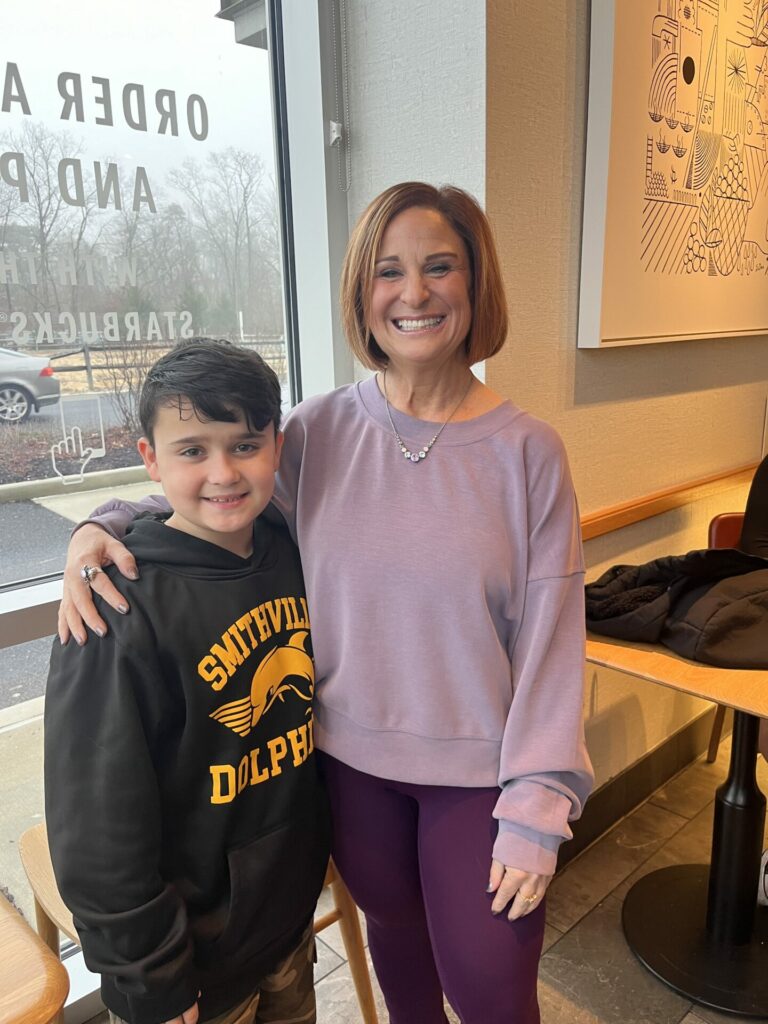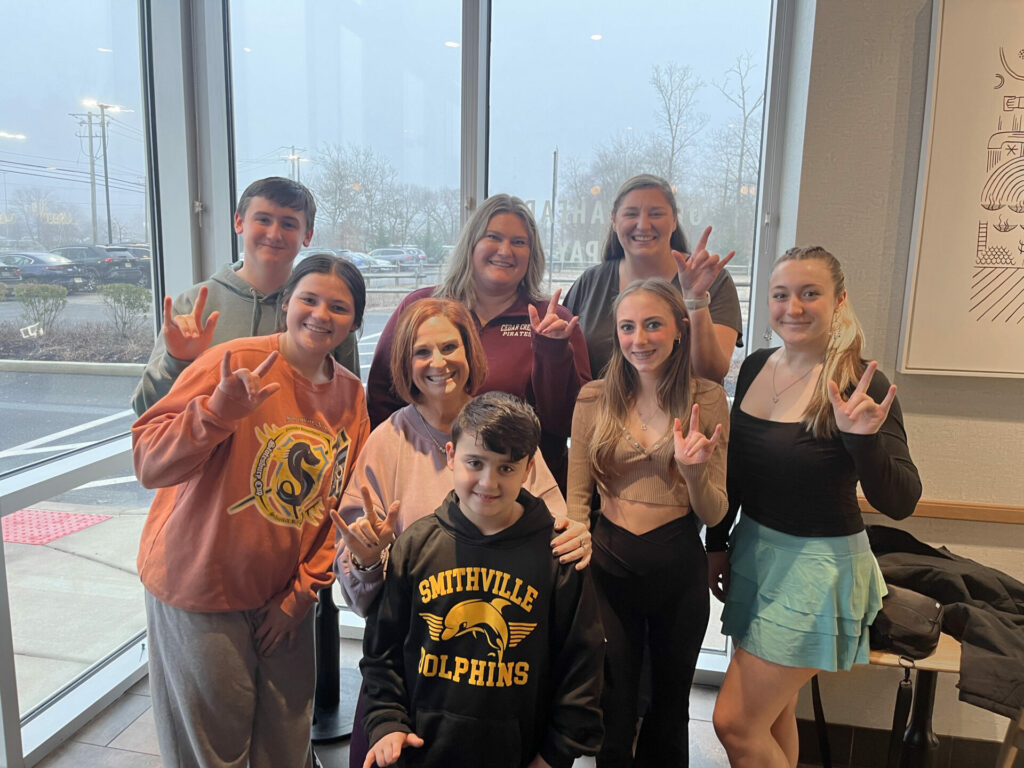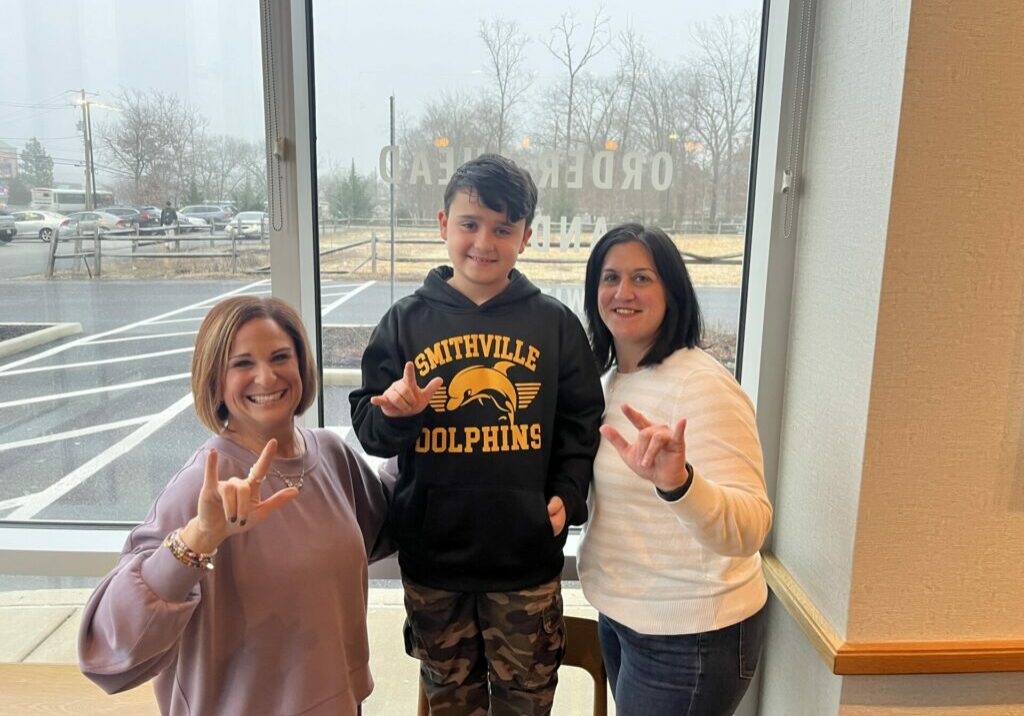By Amy T. Andersen
As a teacher of the Deaf and teacher of American Sign Language (ASL), advocating for every child’s right to their culture and identity has always been as important to me as teaching. In 2018, as the New Jersey State Teacher of the Year, my ability to successfully advocate for Deaf children in my state was magnified, and for that, I will always be most proud and grateful.
This story begins nine years ago when I met the Renart family: two grieving parents, a 6-year-old big brother, and beautiful baby twin boys, one Deaf and one hearing. This family would guide my trajectory to ignite change in a system statewide. This story is about knocking down barriers to guarantee a little boy the educational opportunities he deserves.
This is a story about the day I saw a Deaf baby’s eyes genuinely smile for the first time as he connected to the world around him through ASL. It is about the right that every child has to their voice, spoken or signed, and the human right we all have to communicate.
When I met Cole’s mother, Stephanie Renart, she told me about the day she learned her baby was Deaf. She was sitting in the doctor’s office thinking, “How am I ever going to tell my husband our baby will never hear?”

Barriers to language acquisition
With one Deaf and one hearing twin, as the babies grew up, Renart and her husband couldn’t miss the differences. Ryan was repeating sounds, babbling and responding to simple directions. Cole was not. He couldn’t hear those sounds or simple directions. He was babbling but with his hands.
Renart’s instincts drew her to sign even though the doctors had advised against it. Using visual language made sense, and she was committed to giving her baby a voice. Through early intervention, Cole’s family met with a teacher of the Deaf one day a week for an hour, learning sign language and how to incorporate it into daily routines—one hour per week for eight months, but Cole seemed stuck.
Early intervention systems are family-centric. The service provider goes into the home, works with the parents, and provides activities the parents can work into daily routines within the home. This approach assumes that one of the parents is home with the baby.
There are two obstacles this approach can present for Deaf babies.
First, more than 90% of parents with Deaf children are hearing and do not know sign language, let alone have a fluency level in ASL to provide the regular interactive language a child needs to begin acquiring language.
Second, most families with children have two working parents. In single-parent families, that one parent works. As a result, children may spend most of their waking hours in a daycare setting, not in the home with a stay-at-home parent who can implement what they learn during early intervention sessions.
In a typical daycare environment, the childcare workers interact naturally with the children throughout the day, talking about what a child is playing with, reading stories, and talking about people and things in the environment. Time spent listening to, and interacting with, language is a crucial component of language development.
For Deaf children, daycare is a place without an accessible language. This presents a significant barrier for Deaf babies to acquire a language foundation. Research worldwide shows a systemic increase in the number of Deaf children entering kindergarten at a severe disadvantage due to language deprivation.

Back from left: Jack Brogan (OCHS ‘24), Jennifer Vitagliano (OCHS ‘14), and Emily Krause (OCHS ‘10)
Middle from left: Kaitlin Calloway (OCHS ‘24), Amy Andersen, Alivia Adams (OCHS ‘25), and Ella Mashura (OCHS ‘24)
Front: Cole Renart
The search for community
Cole spent 47 hours a week in a daycare with caring teachers interacting with him but in a language he could not hear. For only one hour a week, Cole had language access when his teacher of the Deaf was working with him. For the other 46 hours, Cole was isolated from his teachers and peers.
Renart knew she needed more, and Cole required more. There needed to be more than one hour a week. She found an ASL class at a local community college and enrolled, desperate for a way to reach her Deaf baby. Renart learned more signs every week and continued to meet with Cole’s early intervention teacher for the Deaf, but Cole still wasn’t making progress. Then, Renart was told that Cole’s teacher for the Deaf was going on maternity leave, and no other teachers in the area were available to work with Cole.
The next day, she went to pick up Cole and Ryan at daycare, and when she walked into the room, Cole was in a corner by himself while the other kids ran around the room laughing. For the first time, she realized just how isolated Cole was. She felt a sense of hopelessness, unsure of how to open up his world in a place where no one could sign, and Cole couldn’t hear the language being used.
That night, Renart went to her ASL class and sat next to her friend Denise, the mother of one of my ASL students. Denise told Renart about our monthly ASL chats with the Deaf community. The next night, at our December ASL Chat, I met Cole and his family for the first time. I immediately introduced them to our local Deaf community, and Renart was able to ask about them growing up Deaf in a hearing world. Later that night, I offered to be Cole’s teacher of the Deaf for his early intervention services. Renart cried that night but not out of despair. She finally felt HOPE.
Advocating for Cole
As I started working with Cole, I knew he needed to be in a language-rich environment, exposed to an accessible visual language with a native user of ASL. For months, I called the early intervention agency I worked for and sent research articles, hoping we could find a way to add visual language to Cole’s daycare environment. I shared everything I knew with Renart, who, as his parent, also began to advocate.
We asked for Cole to have a Deaf, native user of ASL with him in daycare, signing throughout the day, just like the hearing babies had teachers talking to them throughout the day. The agency told us this had never been done before and suggested we teach Cole’s daycare teachers sign language. At that time, Cole was 18 months old and didn’t have time to wait for his teachers to learn some signs. Renart made calls every day and refused to give up.
Finally, we sat down for an emergency meeting in January 2017. Cole’s mother and I provided resources showing the importance of language acquisition for Deaf children, and most importantly, we spoke from our hearts. We advocated for a Deaf American Sign Language user to be placed in Cole’s daycare classroom. Representatives from the early intervention agency expressed concern that we would never find someone like that, even if they approved the request.
Fortunately, we had already found a trusted member of the local Deaf community who was anxious to jump in and be the first to pioneer this approach. With persistence and determination, we finally convinced the New Jersey Early Intervention System to do something they had never done before. Cole became the first Deaf baby in New Jersey and the country to have a Deaf paraprofessional in the daycare setting for 25 hours a week. He finally had access to a visual language he could naturally acquire, and his language exploded!
The world opens up for Cole
When Cole turned 3, he knew his colors, numbers, and animals and could fingerspell M-A-X, the name of his favorite toy dog. Cole could tell his mother he wasn’t feeling well or was scared to ride the Ferris wheel at the boardwalk. He could tell his mother he was excited that his daddy gave him candy, which sometimes got Daddy in trouble.
Cole loved school because he knew that his Deaf language role model would communicate with him and that he could share with his teachers and friends, who were all starting to learn to sign. Soon, many of Cole’s friends signed with him and knew how to get his attention by waving to him or tapping him on the shoulder. Expressing his wants, needs, likes and dislikes opened this toddler’s world and allowed him to forge relationships with his parents, brothers and friends.
Now, as a thriving, bilingual eight-year-old, Cole’s confidence is clear to anyone who meets him. He is a leader and academically on par with his peers. He is on his local basketball team and loves playing Roblox, swimming and FaceTiming with friends. Sometimes, I even get a Marco Polo video from Cole telling me he’s dyeing his hair green for St. Patrick’s Day or showing me a new magic trick he’s learned! Cole wants to be a veterinarian when he grows up.
A program to “Level the Playing Field”
This happy ending did not stop with Cole and the Renart family. In collaboration with Deaf colleagues Michelle Cline and Christopher Sullivan, I submitted a proposal to the New Jersey Legislature called “Leveling the Playing Field: A Language Acquisition Program for Deaf and Hard of Hearing Children.”
The proposal was based on the service model we pioneered with Cole and sought to expand it statewide for all Deaf, hard of hearing, and Deafblind babies and their families. Sure enough, on a surprising day in July, I received a phone call letting me know the proposal was accepted, and the program would receive $550,000 annually to provide this service, free of charge, to families throughout New Jersey. All of those babies and all of those voices now receive access to language in their daycare environments!
The possibilities for Cole became limitless because he was given the gifts of love, language, and voice. Cole’s story shows how one child’s experience can affect many and how education and language access are liberating. It’s a story about parents who refused to take “no” for an answer and about the love and determination of a teacher and community fighting to empower a little boy to succeed, not as a version of everyone else, but as himself.
Cole taught us all that with dedication and hope, we can break down barriers to ensure every child receives the equitable education they deserve!
Editor’s note: To read more about Cole’s story, read “The Leveling the Playing Field Language Acquisition Program for Deaf and Hard of Hearing Children” by Amy T. Andersen, Michelle Cline, Stephanie Renart, and Tiffany Narciso, published in the Teacher Education Journal of South Carolina. Visit njea.org/TEJSC-Andersen to download the article.
Amy Andersen is a doctoral student with research interests in early intervention programming for Deaf and hard-of-hearing babies. As the 2018 New Jersey State Teacher of the Year, she secured funding for an innovative early intervention program for Deaf babies in New Jersey called Leveling the Playing Field. She can be reached at njstoy2018@gmail.com.
